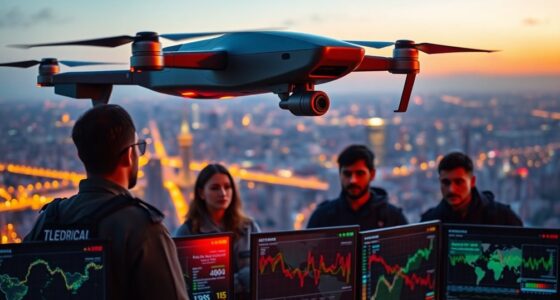If a robotic dog attacks, act quickly. Run to create distance and seek cover in structures like staircases. Keep a safe distance to avoid detection and use visual obstructions like paint to confuse its sensors. If you’re able, try to disable it by pressing power buttons or removing its battery. Always stay alert and informed about deployments. You’ll discover preventive measures and additional strategies to enhance your safety against these advanced threats.
Key Takeaways
- Quickly create distance by running away to evade the robotic dog’s pursuit.
- Seek shelter in structures or narrow spaces to avoid detection and confrontation.
- Use deception techniques, like changing your path frequently, to confuse the robot’s navigation.
- Disable the robot by locating its power button or removing the battery if possible.
- Obstruct its sensors with paint or dust to disrupt its functionality and movement.
Understanding the Threat of Robot Dogs

As robotic dogs become more advanced, it’s crucial to understand the potential threats they pose. Equipped with sophisticated AI, sensors, and actuators, these machines can navigate diverse environments with ease.
Their military applications, including armed variants designed for drone defense, highlight their combat potential. Capable of sprinting faster than most humans, they can swiftly respond to threats. Customizable to perform various tasks, these robots can serve in intelligence, surveillance, and reconnaissance roles, making them versatile assets on the battlefield.
However, the risk of misuse or unintended behavior raises serious public safety concerns. As these technologies evolve, you must stay informed and vigilant about the implications of their deployment in your surroundings.
Recognizing Malfunctions and Sensor Failures

Understanding the threats posed by robotic dogs includes recognizing when these machines malfunction or experience sensor failures.
Start with a visual inspection of their sensors; damage or debris can obstruct their view. Use thermal imaging to spot inconsistent patterns, which may indicate problems.
Pay attention to unusual sounds, as these can signal mechanical or sensor issues. If you notice delays in response to commands, that’s a red flag for software or hardware malfunctions.
Keep an eye on data discrepancies, as inconsistencies often point to sensor failures. Finally, be aware of navigation issues, which can lead to collisions.
Regular maintenance and calibration of sensors guarantee they function correctly, helping you stay safe.
Strategies for Evasion and Avoidance

When faced with a robotic dog, swift action is essential for your safety. First, consider running to create distance; this is your best immediate defense.
Look for cover—structures like staircases or narrow spaces can act as effective barriers. Maintain a safe distance to avoid detection by the robot’s sensors.
Seek shelter in staircases or narrow spaces to create effective barriers and stay out of the robot’s sight.
Employ deception techniques, like creating confusing paths or using narrow beams to hinder navigation. Staying indoors during alerts is vital, as is selecting difficult terrains for the robotic dog to traverse.
Use visual obstructions, such as paint or blankets, to confuse its optical sensors. Always be aware of your surroundings to identify potential hiding spots or escape routes, increasing your chances of evading the threat.
Techniques for Disabling Robotic Dogs

Disabling a robotic dog requires a clear strategy and knowledge of its vulnerabilities.
Start by locating the power or motor lockout buttons; pressing these can halt its movement. If you can access the battery, removing it’s an effective way to disable the robot instantly.
You might also use blunt objects to target its motors, joints, or sensors, causing mechanical disruption. For a tech-savvy approach, consider wireless hacking tools like Flipper Zero to exploit backdoors, or deploy signal jammers to disrupt remote signals.
Obstructing sensors with paint or dust can confuse the robot, while creating physical barriers limits its movement.
Mitigation and Prevention Measures

To effectively mitigate the threat posed by robotic dogs, it’s essential to implement proactive measures that enhance safety and preparedness.
Start by establishing alert systems to keep you informed about robotic dog deployments. Use visual identification techniques, such as recognizing glowing sensors, to spot them early. Securing areas with barriers can prevent their access, while community communication networks help spread sightings quickly.
Establish alert systems and visual identification techniques to enhance awareness and secure areas from robotic dogs.
Prepare safe houses for temporary refuge during attacks. On a broader scale, advocate for legislation that restricts robotic dogs in civilian zones and educate others on identifying threats.
Finally, consider technological solutions that can disable these machines safely, and engage in community training to foster readiness and reduce panic during emergencies.
The Role of Companies and Regulatory Frameworks

As the deployment of robotic dogs becomes more prevalent, companies and regulatory frameworks play an essential role in shaping their safe integration into society.
Firms like Boston Dynamics focus on developing non-armed robots for surveillance, while Robotic Assistance Devices deploys them for security in public areas. These companies emphasize ethical considerations, pledging not to weaponize their robots.
However, a significant gap in extensive regulations remains, making public safety a pressing issue. Countries are called to establish guidelines, yet no global standards exist.
Collaborative efforts between private companies and government agencies drive innovation, but public perception also influences regulatory approaches. Balancing safety and utility is crucial for ensuring that robotic dogs serve as helpful tools rather than sources of fear.
Future Developments in Robot Dog Technology

While advancements in technology continue to shape various industries, the future of robotic dogs is particularly promising. You’ll see increased autonomy, allowing these robots to navigate and execute tasks independently.
With advanced sensor integration, they’ll enhance their ability to interact and detect their surroundings. As components miniaturize, expect more compact and efficient designs. Battery technology improvements will extend their operating time, making them more reliable.
The market is expanding, driven by affordability and rising demand. Future applications include personalized robotics for companionship and roles in elderly care and education.
Enhanced AI algorithms will improve their communication and emotional responsiveness, paving the way for complex tasks like search and rescue operations, showcasing their versatility and utility.
Community Engagement and Public Awareness

Understanding the role of community engagement and public awareness is essential when it comes to the acceptance of robotic dogs. Engaging with your community through promotional events and school programs helps demystify robotic technology.
Public demonstrations showcase their capabilities, fostering transparency and trust. Participating in ethical discussions can address privacy concerns and fears stemming from misinformation.
Safety briefings inform you about how robotic dogs enhance security. Educational workshops clarify the benefits and ethical considerations of this technology.
Frequently Asked Questions
What Features Should I Look for in a Robot Dog?
“Don’t judge a book by its cover.”
When you’re looking for a robot dog, focus on key features like speed, maneuverability, and obstacle handling.
Make certain it has a solid payload capacity and can adapt to different terrains.
Intelligence matters too; look for smart tracking and advanced sensor technology.
Finally, consider durability and safety features that can withstand harsh conditions.
These aspects will make certain you get a reliable and effective robotic companion.
Can Robot Dogs Recognize Specific Individuals?
Yes, robot dogs can recognize specific individuals.
They use advanced facial recognition technology combined with machine learning to differentiate between known people and potential threats.
If you’re in an environment with robot dogs, you might notice how they identify authorized personnel accurately.
This capability enhances their effectiveness in security settings, allowing them to monitor areas and respond appropriately to various individuals.
Are There Ethical Concerns Regarding Robot Dogs?
Yes, there are significant ethical concerns regarding robot dogs.
You’ll notice issues like job displacement in security roles and the moral implications of their military use.
Data privacy is another major concern, as these robots collect sensitive information.
Public backlash is growing due to fears of misuse, prompting calls for regulatory frameworks to guarantee responsible deployment.
It’s essential for you to stay informed about these developments and advocate for ethical practices.
How Do Robot Dogs Communicate With Their Operators?
Robot dogs communicate with their operators through various advanced methods. You might use brain-computer interfaces to send commands directly with your thoughts, while visual cues from augmented reality displays guide your inputs.
If you prefer, you can give vocal commands, and the robot dogs will recognize them. Additionally, real-time feedback from their sensors keeps you informed about their status and surroundings, making your interaction seamless and efficient.
What Are the Most Common Uses for Robot Dogs Today?
Did you know that robot dogs can traverse rough terrain at speeds up to 8.5 miles per hour?
Today, their most common uses include search and rescue operations, where they help locate survivors in disaster zones. In industrial settings, they carry out inspections and data collection, enhancing safety.
Additionally, military applications leverage their advanced navigation for logistical support.
Finally, in homes, they offer companionship and security, showcasing their versatility across various fields.
Conclusion
In a world where robotic dogs are becoming a reality, staying informed and prepared is essential. You can learn to recognize their threats, develop evasion tactics, and even understand how to disable them if necessary. By advocating for stronger regulations and engaging your community, you can help shape the future of robotics. Remember, it’s not just about survival; it’s about thriving in a landscape where technology and humanity coexist harmoniously. Stay vigilant, stay smart, and stay safe.









